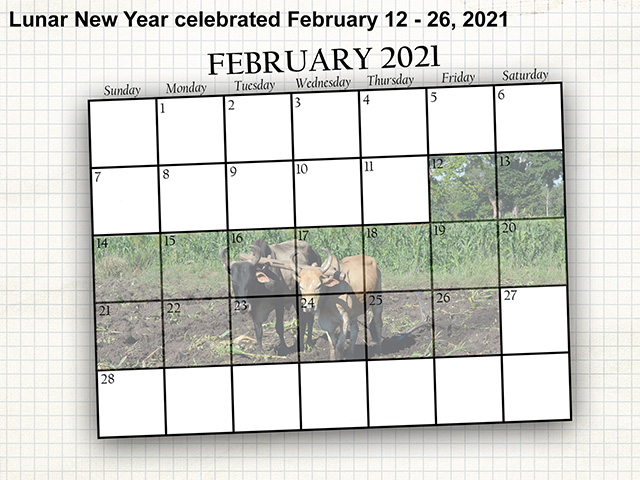Kub's Den
'Year of the Ox' Appropriate for Bullish Markets
When I saw that 2021 is designated as the "Year of the Ox" according to the Chinese zodiac, I thought that seemed very auspicious for a "bullish" sort of year in the commodity markets. However, compared to the image of a snorting, brawling bull, in contrast, every ox I've ever met was a different sort of fellow entirely -- placid, obedient and content to apply his strength in useful forward motion.
Perhaps I shouldn't make too much of the "Year of the Ox" being bullish -- an ox and a bull are not really the same. As a symbol of the Chinese zodiac, the ox is meant to represent agricultural hard work, reliability and calmness.
But as long as either metaphor points to upward or stable prices for commodities, agricultural producers should be satisfied with the 2021 outlook. Global stock markets are at all-time highs. Cash corn is around $5.40 per bushel and soybeans around $13.50, both markets assessing newly tightened U.S. ending stocks projections (1,502 million bushels of corn and 120 mb of soybeans). All varieties of wheat are above $6 per bushel, with the potential that future weather problems or supply shocks anywhere on the globe could set them on a rally. Cotton prices are already streaking higher than they've been since 2018. Live cattle are at $117 per hundredweight with a diminished herd size to keep things interesting. July lean hog futures have traded as high as $90.65 per hundredweight in recent days and export prospects look rosy alongside a weaker U.S. dollar.
P[L1] D[0x0] M[300x250] OOP[F] ADUNIT[] T[]
Eerily, we could have pointed to some of the same bullish developments a year ago (record-high stock markets, rosy prospects for meat exports), not knowing what surprises were in store for us. Speaking of China, in the latest World Agricultural Supply and Demand Estimates (WASDE), USDA increased its projections for China's 2020-21 imports of virtually every crop in the report: wheat, coarse grains, corn (up another 6.5 million metric tons), rice and certainly cotton. Only the Chinese import projections for soybeans were left unchanged at 100 mmt.
Chinese grain traders have recently been buying huge loads of U.S. corn, especially while Australian barley imports are banned (2,108,000 metric tons of U.S. corn sales to China were announced on Jan. 29 and 101,600 mt were announced on Feb. 5 that are likely headed for China). But the Lunar New Year celebrations are approaching, from Feb. 12 through Feb. 26, and ordinarily that's a time when Chinese grain traders have more fun things to do than trade grain. Most years, there tends to be a lull in business during the middle of February while the country closes up shop to feast with family and celebrate with gifts, firecrackers, candies and various day-by-day traditions. (Note for small grains farmers: In China, Feb. 19 is celebrated as the "birthday" of millet.) As gingerbread and sparkling lights are to North America during the last week of December, seven-grain Laba porridge and paper lanterns on the full moon night are to those who celebrate the 4,000-year-old traditions of the Lunar New Year.
Usually, one of the most notable traditions is the mass migration of people back to their hometowns for reunion dinners, all packed on trains, airplanes and buses. This year, however, Chinese factories and businesses are incentivizing their workers not to travel, and local governments are issuing testing and quarantining rules that make it virtually impossible for workers to get home and back within the 15-day holiday window. This is heartbreaking for people who might only see their family, including their children, once each year. But it seems to be working -- train stations are relatively quiet this week and the government predicts a drop in overall trips compared to last year at this time when the COVID-19 pandemic was just beginning to become a huge problem. The city of Wuhan was locked down only two days before the start of the 2020 festival.
Now, if people actually stay in place, what will that do for trading? Traditionally, all stores are closed for the first five days of the 15-day festival. The Dalian Commodity Exchange, where Chinese soybean futures are bought and sold, will be closed from Feb. 11 to Feb. 17. So, there will still be a lull, and one way or another the calendar will trod forward into the "Year of the Ox."
Before you ignore this zodiac metaphor as nothing but superstitious nonsense, consider that 2020 was the "Year of the Rat"' and that turned out to be pretty apt, didn't it? A gentle, trustworthy ox just going about his business, one foot in front of the other -- now that's a spirit I could embrace for the months ahead.
Elaine Kub is the author of "Mastering the Grain Markets: How Profits Are Really Made" and can be reached at masteringthegrainmarkets@gmail.com or on Twitter @elainekub.
(c) Copyright 2021 DTN, LLC. All rights reserved.




